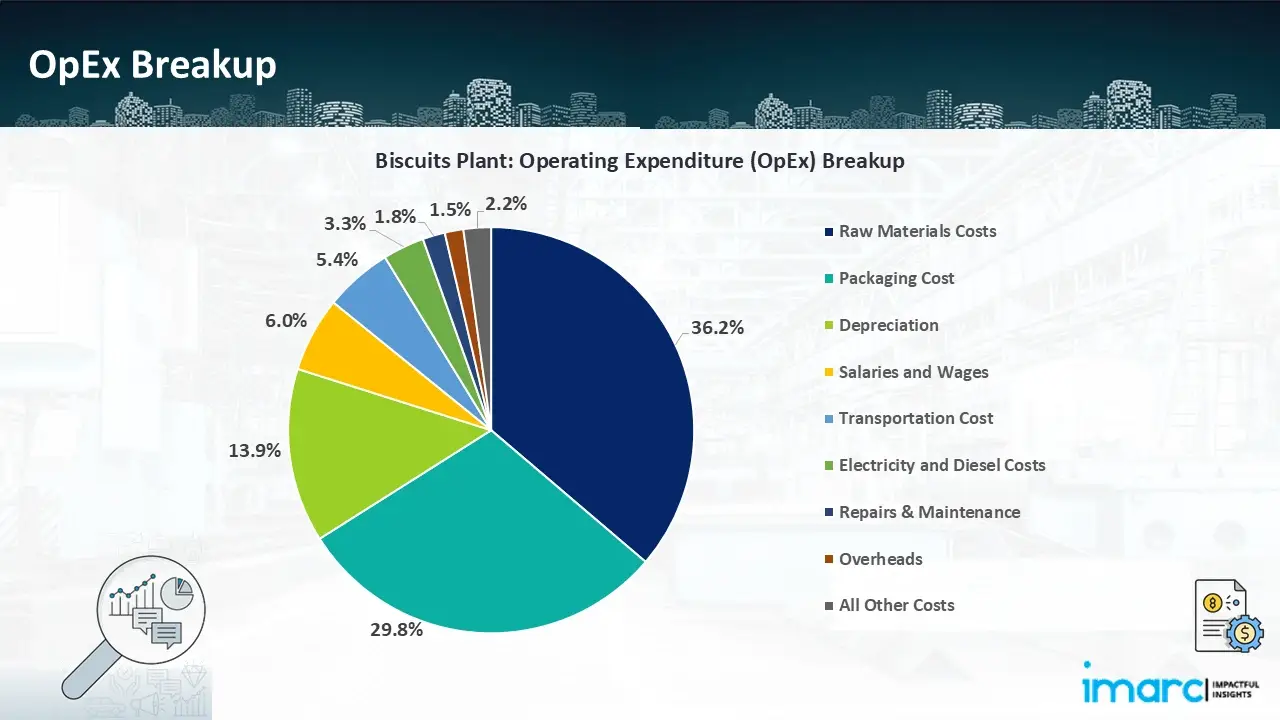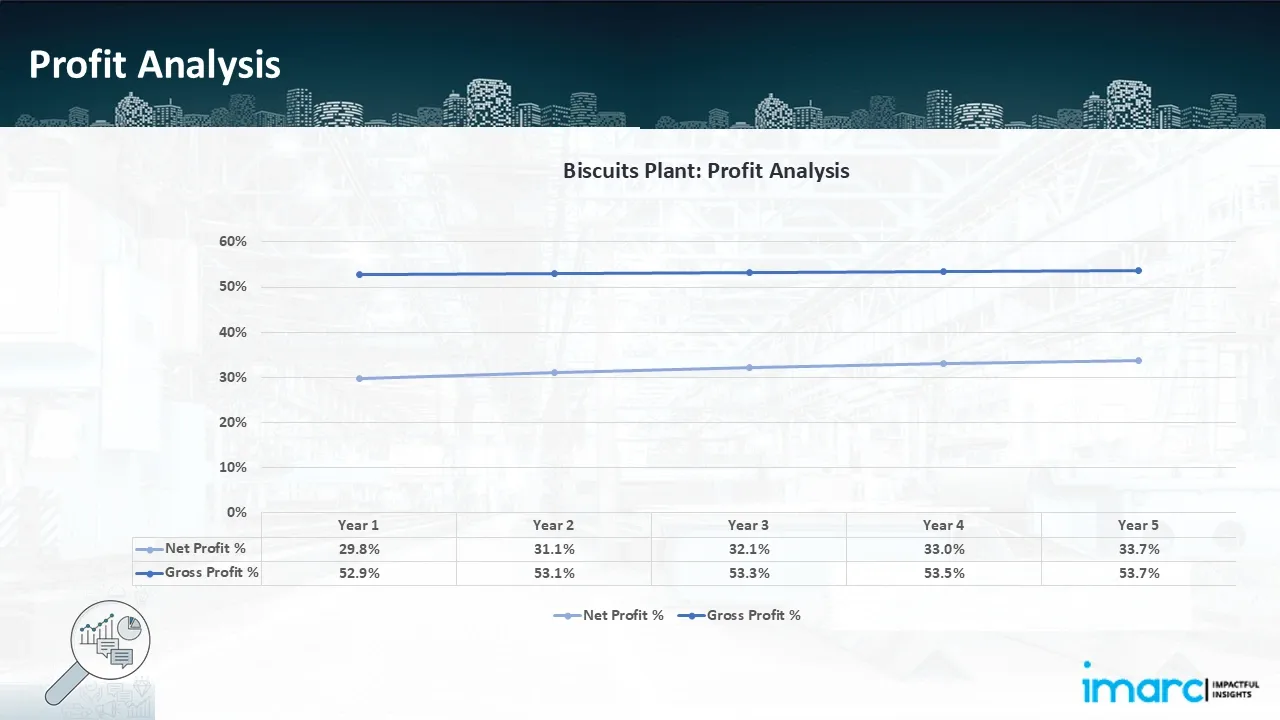Biscuits Manufacturing Economics: A Cost Model Analysis
_11zon.webp)
What is Biscuits?
Biscuits are dry, baked foods made from flour and usually crisp in texture and flat in shape, eaten frequently as a snack or with a meal. They consist mostly of wheat flour, sugar, fat (butter or vegetable oil), and leavening agents such as baking powder.
Key Applications Across Industries:
Flavors and variety may be added using ingredients like milk solids, chocolate, spices, or dried fruits. Biscuits come in sweet and savory forms, varying from cookies and cream-filled to salted crackers. Their shelf life, which is lengthy, convenient packaging, and broad taste appeal have made them a household staple, school staple, and workplace staple worldwide. In most markets, they appeal to both premium and mass consumption segments, making them a very accessible and versatile food category.
What the Expert Says: Market Overview & Growth Drivers
The global biscuits market size was valued at USD 128.65 Billion in 2024. Looking forward, IMARC Group estimates the market to reach USD 187.0 Billion by 2033, exhibiting a CAGR of 4.2% from 2025-2033. The biscuit industry is fueled by a mix of changing consumer trends, convenience requirements, and rising urbanization.
Growth in demand for packaged, ready-to-eat snacks from working professionals and children attending school is a major driver. A shift towards health-consciousness is also impacting product innovation, with growing demand for fiber-rich, sugar-free, and fortified biscuits. The development of modern retail, online platforms, and efficient distribution channels has also improved the availability of biscuits in urban and rural markets. Moreover, aggressive promotional activities, compelling packaging, and varied flavor and form offerings are captivating wide consumers. In emerging economies such as India, increasing disposable incomes and lifestyle changes are widening consumer bases. In addition, biscuits provide a relatively low-cost indulgence in inflationary times, regularly replacing costlier snack alternatives. Lastly, government policies favoring the food processing sector and FDI inflows have also added to the growth of biscuit manufacturing facilities and investment.
Case Study on Cost Model of Biscuits Manufacturing Plant:
Objective
One of our clients reached out to us to conduct a feasibility study for setting up a large-scale biscuits manufacturing plant.
IMARC Approach: Comprehensive Financial Feasibility
We developed a comprehensive financial model for the setup and operation of a proposed biscuits manufacturing plant in Haiti. This plant is designed to produce 1,500 kg of biscuits per hour.
Manufacturing Process: Soft biscuit manufacture requires a series of carefully regulated processes to guarantee quality, flavor, and texture. It starts with blending where wheat flour and sugar are mixed together, with the moisture level kept at 16–18% and dough temperature controlled between 22°C to 28°C. Then, during the forming operation, dough is fed into a rotary molding machine where biscuits are molded into differing shapes by interchangeable molds. Next is baking, wherein the dough, given its oil and sugar content, is baked at high temperatures (250–280°C front, 220–240°C centre, and 180–200°C back) for approximately 5–6 minutes. After baking, an oil spray is sprayed to improve appearance and flavor, creating a glossy appearance for the biscuits. The cooling process then follows to enhance crispness and shelf life. Quality inspections are conducted on every 30 minutes to ascertain uniformity in terms of size, shape, and color. Packaging is done last, typically utilizing small bag sizes that provide convenience, portioning, and freshness preservation to final consumers.
_11zon.webp)
Get a Tailored Feasibility Report for Your Project Request Sample
Mass Balance and Raw Material Required: The primary raw materials used in the biscuits manufacturing plant include wheat flour, palm oil, ammonium bicarbonate, baking soda, salt, water, shortening, potassium metabisulfite, malt syrup, corn starch, sodium bicarbonate and potassium aluminum sulfate. For a plant producing 1 ton of biscuits, 0.6665 ton of wheat flour, 0.0267 ton of palm oil, 0.0267 ton of ammonium bicarbonate, 0.0053 ton of baking soda, 0.0013 ton of salt, 0.0801 ton of water, 0.0400 ton of shortening, 0.0013 ton of potassium metabisulfite, 0.1600 ton of malt syrup, 0.0067 ton of corn starch, 0.0005 ton of sodium bicarbonate and 0.0009 ton of potassium aluminum sulfate tape is required.
Techno-Commercial Parameter:
- Capital Investment (CapEx): Capital expenditure (CapEx) in a manufacturing plant includes various investments essential for its setup and long-term operations. It covers machinery and equipment costs, including procurement, installation, and commissioning. Civil works expenses involve land development, factory construction, and infrastructure setup. Utilities such as power, water supply, and HVAC systems are also significant. Additionally, material handling systems, automation, environmental compliance, and safety measures are key components. Other expenditures include IT infrastructure, security systems, and office essentials, ensuring operational efficiency and business growth.
- Operating Expenditure (OpEx): Operating expenditure is the cost incurred to operate a manufacturing plant effectively. Opex in a manufacturing plant typically includes the cost of raw materials, utilities, depreciation, taxes, packing cost, transportation cost, and repairs and maintenance. The operating expenses are part of the cost structure of a manufacturing plant and have a significant effect on profitability and efficiency. Effective control of these costs is necessary for maintaining competitiveness and growth.

- Profitability Analysis Year on Year Basis: The proposed biscuits plant, with a capacity of approximately 1,500 kg of biscuits per hour, achieved an impressive revenue of US$ 1.9 million in its first year. We assisted our client in developing a detailed cost model, which projects steady growth, with revenue rising throughout the projected period. Moreover, gross profit margins improve from 52.9% to 53.7% by year 5, and net profit rises from 29.8% to 33.7%, highlighting strong financial viability and profitability.

Conclusion & IMARC's Impact:
Our financial model for the biscuits manufacturing plant was meticulously developed to meet the client’s objectives, providing an in-depth analysis of production costs, including raw materials, manufacturing, capital expenditure, and operational expenses. By addressing the specific requirements of producing 1,500 kg of biscuits per hour, we successfully identified key cost drivers and projected profitability, considering market trends, inflation, and potential fluctuations in raw material prices. This comprehensive financial model equipped the client with valuable insights for strategic decision-making, demonstrating our commitment to delivering high-quality, client-focused solutions that ensure the long-term success of large-scale manufacturing ventures.
Latest News and Developments:
- In July 2025, Pladis, the firm behind GODIVA and McVitie's, is supporting Britain by investing £68 million in all of its UK operations. The investment is expected to reduce 876 tonnes of carbon emissions annually and expand the company's activities in Carlisle, Stockport, and Liverpool.
- In July 2025, Fox Burton’s Companies has announced a huge change for its Maryland brand, with the launch of its brand-new sandwich biscuit. The Maryland S'wich is the first significant change to the company's recognisable dessert lineup. The only chocolate chip cookie sandwich in the UK, it blends a number of delectable tastes. A classic Maryland chocolate chip cookie, the S'wich is stuffed with a rich, creamy chocolate filling.
- In June 2024, Lotus Bakeries is partnering with Mondelez to expand its Biscoff brand in India and co-develop chocolate-infused Biscoff products, with the first launches planned in early 2025.
Why Choose IMARC?
IMARC's Financial Model Expertise: Helping Our Clients Explore Industry Economics
IMARC is a global market research company that offers a wide range of services, including market entry and expansion, market entry and opportunity assessment, competitive intelligence and benchmarking, procurement research, pricing and cost research, regulatory approvals and licensing, factory setup, factory auditing, company incorporation, incubation services, recruitment services, marketing and sales.
Under our factory setup services, we assist our clients in exploring the feasibility of their plants by providing comprehensive financial modeling. Additionally, we offer end-to-end consultation for setting up a plant in India or abroad. Our financial modeling includes an analysis of capital expenditure (CapEx) required to establish the manufacturing facility, covering costs such as land acquisition, building infrastructure, purchasing high-tech production equipment, and installation. Furthermore, the layout and design of the factory significantly influence operational efficiency, energy consumption, and labor productivity, all of which impact long-term operational expenditure (OpEx). So, every parameter is covered in the analysis.
At IMARC, we leverage our comprehensive market research expertise to support companies in every aspect of their business journey, from market entry and expansion to operational efficiency and innovation. By integrating our factory setup services with our deep knowledge of industry dynamics, we empower our clients to not only establish manufacturing facilities but also strategically position themselves in highly competitive markets. Our financial modeling and end-to-end consultation services ensure that clients can explore the feasibility of their plant setups while also gaining insights into competitors' strategies, technological advancements, and regulatory landscapes. This holistic approach enables our clients to make informed decisions, optimize their operations, and align with sustainable practices, ultimately driving long-term success and growth.
Our Clients
Contact Us
Have a question or need assistance?
Please complete the form with your inquiry or reach out to us at
Phone Number
+91-120-433-0800+1-201-971-6302
+44-753-714-6104











